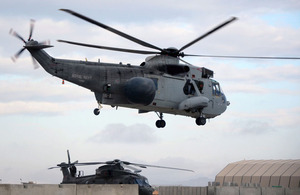Navy Sea Kings complete 1,000th mission in Afghanistan
The Royal Navy's Sea King Mk7 Force completed their 1,000th operational mission in Afghanistan yesterday.

A Sea King Airborne Surveillance and Control Mk7 helicopter takes off from Camp Bastion, Afghanistan [Picture: LA(Phot)Alex Cave, Crown Copyright/MOD 2011]
Sea King helicopter squadrons from Royal Naval Air Station (RNAS) Culdrose have been operating from Camp Bastion since 2009 and have contributed to the confiscation of significant amounts of IED-making equipment, arms and drugs, and the detainment of suspected insurgents.
Following their help, on a recent vehicle interdiction, ground forces seized over 1,200kg of unprocessed wet opium with a street value of around £1.9m.
Royal Navy Airborne Surveillance and Control helicopters operate like ‘flying radar stations’, detecting enemy aircraft, ships and even vehicle movements over land.
Their job is primarily to provide Royal Navy ships with protection against low-flying enemy aircraft and missiles, using radar to detect enemy aircraft, feeding the information back to the ship for investigation, and, if necessary, directing the aircraft sent to intercept them.
However, the helicopters are currently proving equally effective operating over land, providing wide area surveillance in Afghanistan. Being based on-scene at Camp Bastion, aircrews are able to react swiftly to events on the ground, directing coalition aircraft and ground forces to investigate, and in some cases destroy, suspected enemy targets.
Two RNAS Culdrose-based squadrons take rotating one-year tenures in theatre. During their time in theatre, 854 and 857 Naval Air Squadrons have enabled the discovery of significant amounts of IED-making equipment, arms, drugs and suspected insurgents.
They have regularly directed ground forces to vehicles laden with fertiliser, electric wiring and batteries, all of which are used to make explosives. Their actions have directly helped to save the lives of Afghan citizens and coalition troops.
Operating in desert conditions in temperatures ranging from minus 10 to 45 degrees Celsius, and, with the ever-present threat of enemy action, the helicopters have had a number of enhancements fitted. They have improved engines and different rotor blades, are night-vision-capable, and carry a sophisticated defensive aids suite.
To maintain the core maritime skills of our Sea King crews, the ‘off watch’ squadron embarks upon various Royal Navy warships to hone their maritime skills, ensuring that they remain fully capable of protecting UK forces at sea.
The Sea King Force Commander, Commander Pat Douglas, is very proud of the achievements of the Sea King Force, who are fulfilling a role quite different from their usual maritime one. He said:
Since May 2009, Sea King helicopters from RNAS Culdrose have been operating continuously in Afghanistan. Using the aircraft’s powerful radar by day and night, our aircrew are able to watch the movements of vehicles and suspect targets over a wide area.
Able to search huge areas very swiftly, they are proving to be essential in the ongoing fight against the insurgents.
Following information gained from our Sea Kings, UK and coalition forces have stopped many vehicles and, on investigation, found large quantities of ammunition and weapons in addition to literally tonnes of material used to make IEDs.
Each of these successful interceptions means that less IEDs will be planted in Afghanistan, making it a safer place for both our troops and the Afghan people.